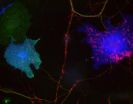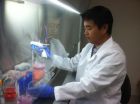(Press-News.org) Japanese researchers show for the first time that primates modify their body movements to be in tune with others, just like humans do. Humans unconsciously modify their movements to be in synchrony with their peers. For example, we adapt our pace to walk in step or clap in unison at the end of a concert. This phenomenon is thought to reflect bonding and facilitate human interaction. Researchers from the RIKEN Brain Science Institute report today that pairs of macaque monkeys also spontaneously coordinate their movements to reach synchrony.
This research opens the door to much-needed neurophysiological studies of spontaneous synchronization in monkeys, which could shed light into human behavioral dysfunctions such as those observed in patients with autism spectrum disorders, echopraxia and echolalia – where patients uncontrollably imitate others.
In the research, published today in the journal Scientific Reports, the team led by Naotaka Fujii developed an experimental set-up to test whether pairs of Japanese macaque monkeys synchronize a simple push-button movement.
Before the experiment, the monkeys were trained to push a button with one hand. In a first experiment the monkeys were paired and placed facing each other and the timing of their push-button movements was recorded. The same experiment was repeated but this time each monkey was shown videos of another monkey pushing a button at varying speeds. And in a last experiment the macaques were not allowed to either see or hear their video-partner.
The results show that the monkeys modified their movements – increased or decreased the speed of their push-button movement - to be in synchrony with their partner, both when the partner was real and on video. The speed of the button pressing movement changed to be in harmonic or sub-harmonic synchrony with the partners' speed. However, different pairs of monkeys synchronized differently and reached different speeds, and the monkeys synchronized their movements the most when they could both see and hear their partner.
The researchers note that this behavior cannot have been learnt by the monkeys during the experiment, as previous research has shown that it is extremely difficult for monkeys to learn intentional synchronization.
They add: "The reasons why the monkeys showed behavioral synchronization are not clear. It may be a vital aspect of other socially adaptive behavior, important for survival in the wild."
### The study was partly supported by Grant-in-Aid for Scientific Research on Innovative Areas 'Neural creativity for communication' (22120522 and 24120720) of MEXT, Japan.
For more information please contact:
Juliette Savin
Global Relations Office
RIKEN
Tel: +81-(0)48-462-1225 / Fax: +81-(0)48-463-3687
email: pr@riken.jp
Reference
Yasuo Nagasaka, Zenas C. Chao, Naomi Hasegawa, Tomonori Notoya, and Naotaka Fujii
"Spontaneous synchronization of arm motion between Japanese macaques." Scientific Reports, 2013 DOI: 10.1038/srep01151.
About RIKEN:
RIKEN is Japan's flagship research institute for basic and applied research. Over 2500 papers by RIKEN researchers are published every year in reputable scientific and technical journals, covering topics ranging across a broad spectrum of disciplines including physics, chemistry, biology, medical science and engineering. RIKEN's advanced research environment and strong emphasis on interdisciplinary collaboration has earned itself an unparalleled reputation for scientific excellence in Japan and around the world.
Website: www.riken.jp
Find us on Twitter at @rikenresearch
About the RIKEN Brain Science Institute:
The RIKEN Brain Science Institute (BSI) was established to answer a growing need in society for cutting-edge brain science research and today enjoys an international reputation as an innovative center for brain science. Research at BSI integrates a wide range of disciplines including medicine, biology, physics, technology, information science, mathematical science, and psychology. BSI's research objectives cover individual organisms, behavior, microscopic molecular structures of the brain, neurons, neurocircuits, cognition, memory, learning, language acquisition, and robotics.
Primates too can move in unison
2013-01-28
ELSE PRESS RELEASES FROM THIS DATE:
Misconceptions about a popular pet treat
2013-01-28
GRAFTON, Mass. (January 28, 2013)—A popular dog treat could be adding more calories than pet owners realize, and possibly be contaminated by bacteria, according to a study published this month by researchers at the Cummings School of Veterinary Medicine at Tufts University and the University of Guelph.
The treat in question: the "bully" or "pizzle stick." The American and Canadian researchers analyzed the caloric density and bacterial contamination of these popular items, made from the uncooked, dried penis of a bull or steer. They also administered a survey to pet owners ...
Protein family linked to autism suppresses the development of inhibitory synapses
2013-01-28
Synapse development is promoted by a variety of cell adhesion molecules that connect neurons and organize synaptic proteins. Many of these adhesion molecules are linked to neurodevelopmental disorders; mutations in neuroligin and neurexin proteins, for example, are associated with autism and schizophrenia. According to a study in The Journal of Cell Biology, another family of proteins linked to these disorders regulates the function of neuroligins and neurexins in order to suppress the development of inhibitory synapses.
Like neurexins and neuroligins, the neuronal proteins ...
DNA-repairing protein may be key to preventing recurrence of some cancers
2013-01-28
Just as the body can become resistant to antibiotics, certain methods of killing cancer tumors can end up creating resistant tumor cells. But a University of Central Florida professor has found a protein present in several types of cancer, including breast and ovarian cancer, which could be helpful in preventing tumors from coming back.
The protein, KLF8, appears to protect tumor cells from drugs aimed at killing them and even aid the tumor cells' ability to regenerate.
"All cells have a DNA-repair mechanism," explained Jihe Zhao, a medical doctor and researcher who ...
Global research team decodes genome sequence of 90 chickpea lines
2013-01-28
Hyderabad, India, and Shenzhen, China (28 January 2013) – In a scientific breakthrough that promises improved grain yields and quality, greater drought tolerance and disease resistance, and enhanced genetic diversity, a global research team has completed high-quality sequencing of not one but ninety genomes of chickpea.
Nature Biotechnology, the highest ranked journal in the area of biotechnology, featured the reference genome of the CDC Frontier chickpea variety and genome sequence of 90 cultivated and wild genotypes from 10 different countries, as an online publication ...
Radial access should be first choice for PCI says ESC
2013-01-28
Sophia Antipolis, 28 January 2013: The radial approach for percutaneous coronary interventions (PCI) was developed 20 years ago and is used for more than 50% of procedures in France, Scandinavian countries, the UK, Spain and Italy. Despite the advantages of radial access some countries in Europe such as Germany use radial access for fewer than 10% of PCI.
Evidence has accumulated in the literature showing the benefits of radial over femoral access for PCI including reduced bleeding and improved survival. In addition, the development of smaller and thinner devices has ...
New technique sheds light on RNA
2013-01-28
ANN ARBOR, Mich. — When researchers sequence the RNA of cancer cells, they can compare it to normal cells and see where there is more RNA. That can help lead them to the gene or protein that might be triggering the cancer.
But other than spotting a few known instigators, what does it mean? Is there more RNA because it's synthesizing too quickly or because it's not degrading fast enough? What part of the biological equilibrium is off?
After more than a decade of work, researchers at the University of Michigan Comprehensive Cancer Center have developed a technique to ...
Study finds energy use in cities has global climate effects
2013-01-28
TALLAHASSEE, Fla. ⎯ The heat generated by everyday energy consumption in metropolitan areas is significant enough to influence the character of major atmospheric circulation systems, including the jet stream during winter months, and cause continental-scale surface warming in high latitudes, according to a trio of climate researchers that includes Ming Cai, a professor in Florida State University's Department of Meteorology.
Led by Guang Zhang, a research meteorologist at Scripps Institution of Oceanography at the University of California, San Diego, the scientists ...
University of Tennessee researcher finds 'first time' could predict sexual satisfaction
2013-01-28
Research conducted by Matthew Shaffer, a doctoral psychology student at UT and C. Veronica Smith, an assistant psychology professor at the University of Mississippi, reveals that the first sexual experience can set the tone for the rest of one's sexual life.
The study is published in the Journal of Sex and Marital Therapy and is the first to look at whether the circumstances of losing one's virginity have lasting consequences.
"The loss of virginity is often viewed as an important milestone in human development, signifying a transition to adulthood," said Shaffer. ...
Majority of Americans support dozens of policies to strengthen US gun laws
2013-01-28
The majority of Americans support a broad array of policies to reduce gun violence, according to a new national public opinion survey conducted by researchers at the Johns Hopkins Bloomberg School of Public Health. These policies include: requiring universal background checks for all gun sales (supported by 89 percent); banning the sale of military-style semiautomatic assault weapons (69 percent); banning the sale of large-capacity ammunition magazines (68 percent); and prohibiting high-risk individuals from having guns, including those convicted of a serious crime as a ...
Phone and mailed interventions significantly increase colorectal cancer screening rates
2013-01-28
PHILADELPHIA—A mailing or phone call to help patients get screened for colorectal cancer significantly increases their chances of actually getting tested, according to a study published in the January issue of Cancer Epidemiology, Biomarkers and Prevention by researchers at the Kimmel Cancer Center at Jefferson.
The research team, led by Ronald E. Myers, Ph.D., Professor and Director of Division of Population Science, Department of Medical Oncology at Thomas Jefferson University, performed a randomized, controlled trial of 945 people aged 50-79 to test the impact of a ...



